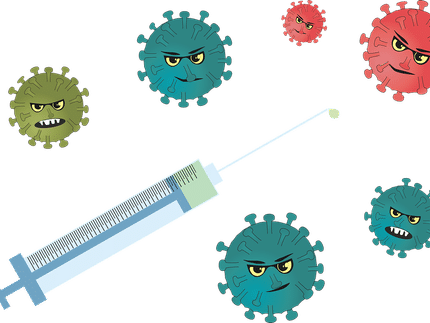Tailor-made vaccines could almost halve rates of serious bacterial disease
Innovative study points the way to more effective vaccine design
New research has found that rates of disease caused by the bacterium Streptococcus pneumoniae could be substantially reduced by changing our approach to vaccination. Researchers from the Wellcome Sanger Institute, Simon Fraser University in Canada and Imperial College London combined genomic data, models of bacterial evolution and predictive modelling to identify how vaccines could be optimised for specific age groups, geographic regions and communities of bacteria.

Symbolic image
Photo by CDC on Unsplash
The study simulated the performance of vaccines over time to assess the risk of vaccine-targeted strains being replaced by other potentially dangerous strains. Through this predictive modelling approach, the researchers identified new vaccine designs that could help reduce overall rates of disease.
S. pneumoniae is often found at the back of the nasal cavity, where it is normally harmless. But when it migrates to other parts of the body, it can cause serious bacterial infections such as pneumonia, sepsis and meningitis - known collectively as invasive pneumococcal disease (IPD). IPD was estimated to cause around 1.6 million deaths per year worldwide prior to the introduction of widespread vaccination, with higher rates of disease in many low- or middle- income countries. Infants and the elderly are most at risk.
Vaccines against pneumococcus have prevented millions of infections. But like many bacteria, S. pneumoniae is difficult to target with vaccines because infection can be caused by different serotypes. Each part of a vaccine usually protects against a single serotype, with the most complex pneumococcal conjugate vaccine (PCV13) targeting 13 serotypes.
Because there are approximately 100 S. pneumoniae serotypes around the world, vaccine effectiveness varies between countries depending on which serotypes are present. When serotypes are removed from circulation by a particular vaccine, other serotypes of S. pneumoniae rise to take their place.
In this study, researchers at the Wellcome Sanger Institute, Simon Fraser University and Imperial College London optimised a computer model to approximate the effect of vaccines targeting different serotype combinations. Analysis of vaccine effectiveness was then carried out on S. pneumoniae genomic data from Massachusetts, USA and the Maela refugee camp in Thailand.
The complexity of S. pneumoniae vaccines means many designs are possible, each with different effects on disease. In Maela, for example, the presence of 64 S. pneumoniae serotypes means around 100 trillion vaccine designs are possible. But it would take 19,000 years to simulate them all, with most being sub-optimal. The researchers developed a more efficient method that made it feasible to identify the best-performing designs from the trillions of possibilities.
The team discovered that rates of infant IPD in Maela could actually be reduced by omitting components from the PCV13 vaccine to keep certain serotypes in place, removing the possibility of their replacement by highly-invasive serotypes. In Massachusetts, a vaccine targeting 20 serotypes was found to be more effective than the current PCV13.
The results highlight the need for vaccine programmes to be tailored to specific communities of bacteria and to consider vaccination at different ages.
Dr Nicholas Croucher, of the MRC Centre for Global Infectious Disease Analysis, Imperial College London, said: "Our research shows that the best vaccine designs strongly depend on the bacterial strains present in the population, which vary considerably between countries. The best vaccine designs also depend on the age group being vaccinated. These ideas will be critical for applying lessons learned from introducing vaccines in high-income countries to combatting the disease where the burden is highest."
Vaccination of infants also affects IPD in adults. However, trends in IPD can differ between infants and the elderly in the same country, as seen recently in the UK. In many places, older adults already receive an S. pneumoniae vaccine, which was designed before the infant vaccine. The study also found that adult disease rates could be reduced by almost 50 per cent by redesigning adult vaccines to complement those administered to infants.
Professor Caroline Colijn, of Simon Fraser University and the Wellcome Sanger Institute, said: "This approach to optimising vaccines will help to address several problems, such as invasive disease among infants or adults and minimising antibiotic resistance in the post vaccine population. Such an approach also enables public health policy-makers to assess the likely effectiveness of an existing vaccine for a local population based on genomic surveillance data."
The findings coincide with growing alarm at the threat of antimicrobial resistance (AMR) to common medicines. S. pneumoniae infections are sometime resistant to multiple antibiotics and have been highlighted as a priority threat by the WHO. This study highlighted how vaccines can be designed to reduce the chances that a person's S. pneumoniae would be resistant to common treatments.
Professor Jukka Corander, of the University of Oslo, University of Helsinki and the Wellcome Sanger Institute, said: "With the power of the latest DNA sequencing technology we are heading towards a future where large-scale genomic surveillance of major bacterial pathogens is feasible. The approach we describe in this study will play an important role in accelerating future vaccine discovery and design to help reduce rates of disease."





















































